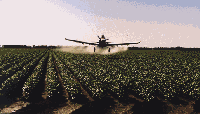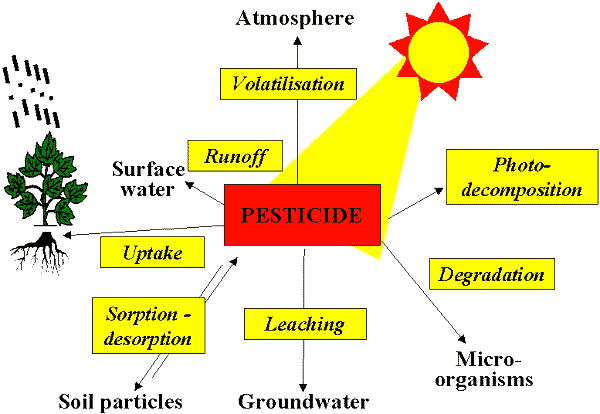|
PEST CONTROL
What happens to pesticides after application? It is important to know what happens to pesticides after they are applied in the field either by aerial or ground application (Fig. 2).
Figure 2. Pesticide application using agricultural aircraft Applying pesticides under optimal meteorological conditions by ground rig, should reduce the chances for drift to non-target sites, with more of the applied chemical reaching the target site. However, serious drift is still possible under abnormal conditions. If pesticides are applied by aerial spraying, the chances for drift to non-target sites can be greater and even more care regarding meteorological conditions, wind direction and proximity to sensitive sites may be required. Of the pesticide remaining at the application site, three major processes determine its fate: adsorption or binding to soil particles, transfer and degradation or persistence (Fig.3). Among the various processes discussed below, adsorption onto soil particles and degradation are the two most important processes affecting the transport of pesticides to contaminate surface or groundwater. Adsorption or binding is the chemical process that results in a pesticide being bound or adsorbed to a soil particle. Pesticide molecules mostly tend to stick onto soil organic matter or clay. Transfer or transport refers to processes that move the pesticide away from the application site and include volatilisation, runoff, leaching, absorption and crop removal. Sometimes chemical transfer is essential for effective control of the pest. For example, certain soil applied pre-emergence herbicides must move within the soil to reach germinating weed seeds. In general volatilisation losses are low for most pesticides but, in some cases, the losses can be as high as 75-90% of the applied mass of chemical. Runoff occurs when water is added to a field faster than it can be absorbed into the soil. Pesticides may move with runoff as compounds dissolved in water or attach to soil particles. Leaching is the downward movement of a chemical through the soil, eventually reaching the groundwater. Absorption is the uptake of a chemical into the plant or animal. After absorption, the chemical may be broken down or remain in the plant or animal. Crop removal through harvest or grazing may move chemical residues into different compartments of the environment. Figure 3. Factors affecting pesticide fate and transport Degradation is the process of chemical breakdown after application. This occurs either by microbial action, chemical action or photodegradation. The degradation of a chemical is indicated by its half-life, which may take hours, days, weeks or years, depending on environmental conditions and the chemical characteristics of the pesticide.
Soil acts as a major sink for many pesticides that are added through soil incorporation or aerial application. The behaviour of pesticides in the soil environment is governed by soil properties, pesticide properties and environmental conditions. Some of the factors that should be considered when selecting pesticides with minimal impact on the environment and water quality are: Pesticide properties:
Soil properties:
Management practices:
For example, if applied directly to soil, there is a greater probability that more of the applied pesticide will be available for leaching or runoff than if the chemical is applied to the foliage. If the pesticide is incorporated into the soil, leaching may be the most important loss pathway. Pesticide applied to the foliage may be lost to the atmosphere or decomposed by sunlight thereby reducing the amount available for wash-off and transport to water bodies. Irrigation practices can also determine the loss pathways of pesticides. Pesticides often move with water, so the less excess water that is applied, the less potential there is for a herbicide to move past the crop root zone or to runoff in surface water. Rainfall can also wash off significant quantities of pesticides from the treated zone. The risk of a particular pesticide to contaminate our waterways depends on field characteristics, application factors and pesticide properties. Considering the inadequacy of the available information, it is proposed to estimate the relative risk of pesticides to surface or groundwater using soil (organic matter and texture) and pesticide properties (water solubility, soil adsorption, degradation or persistence and toxicity; Hornsby, 1992). These factors for a chemical can be easily obtained. Soil adsorption or binding is measured by Koc, which is the tendency of pesticide to be attached to soil particles. Higher Koc values (> 1000) indicate a chemical that is strongly attached to soil and is less likely to move unless soil erosion occurs. Lower Koc values (< 300 - 500) indicate that chemicals tend to move with water and have the potential to leach or move with surface runoff. Solubility is a measure of how easily a chemical may be washed off the treated site, leached into the soil, or move with surface runoff. Chemicals with solubilities of less than 1 mg/L in water tend to remain on the soil surface. They tend not to be leached, but may move with soil sediment in surface runoff if soil erosion occurs. Chemicals with water solubility greater than 30 mg/L are more likely to move with water either through the soil profile or surface runoff. Persistence of a chemical is measured in terms of half-life. In general, the longer the half-life, the greater the potential for chemical transport to non-treated sites. An example of rating the risk of some commonly used pesticides for crop production according to three factors, adsorption or binding to soil particles, water solubility and degradation half-life, is shown in Table 1. along with two toxicological parameters (drinking water health guideline value and aquatic toxicology value). Not all the pesticides registered (600+ active ingredient) for use in crop production in Australia are listed in the Table below. However, some of the commonly used pesticides in crop production or pesticides that have been detected in surface waters and groundwater are included. Table 1. Relative risk estimates for some commonly used pesticides in crop production
*Sorption (Koc) and half-life of pesticides data are from overseas soils; F = fungicide; I = insecticide, H = Herbicide; N = nematicide = adopted from Hornsby (1992); na = not available The risk rating (Table 1) for pesticides that are likely to come in contact with soil are approximations and may vary depending on environmental factors at an individual field. The ratings for transport by leaching or surface runoff do provide relative risk estimates for water quality however, and are useful for farmers or catchment managers for comparisons between products. The drinking water health guideline value provides a measure of pesticide toxicity to humans. The guideline is the concentration of pesticide in drinking water that is not expected to cause any adverse health effects over a lifetime of exposure (70 yr), with a margin of safety. The smaller the value the greater is the toxicity to humans. The aquatic toxicity provides a measure of pesticide toxicity to aquatic species. The values used are the lethal concentration (96-h exposure) at which 50% of the test species (rainbow trout) die (LC50). The smaller the value the greater is the toxicity to aquatic species. Since the toxicity value for the most sensitive aquatic organisms is not frequently available, we have used the LD50 value for rainbow trout that is commonly available. When pesticides need to be used, selection should be influenced by the specific characteristics of each field (soil characteristics, proximity to waterways, slope and crop cover) application factors and pesticide properties. Local agronomist/entomologist in the area can be contacted to assist in choosing a chemical for a particular pest or weeds. The selection of chemicals encourages the grower to move away from the chemicals of high risk as shown in the above table for water quality and toxicity to humans and aquatic organisms rather than defining the best choice. Although certain pesticides have the potential to contaminate our environment and agricultural produce, it is essential to follow management strategies that minimise the risks to health, the environment and trade.
Integrated Pest Management (IPM), the practice of using management systems for diseases, insects, nematodes and weeds which do not rely solely on chemicals but place increasing emphasis on biological and other cultural methods. Integrated Crop Management (ICM) techniques, which seek to reduce the need for off-farm inputs, emphasising non-chemical pest control techniques and the use of resistant cultivars, crop rotations and selection of environmentally safe chemicals. In the UK the National Farmers' Union and a group of major retailers have developed ICM protocols which integrate management strategies with existing production methods for over 30 different crops. Integrated Farming System (IFS), which attempts to optimise a range of inputs including chemical use, reducing environmental damage while maximising profitability. The aim is to create viable production systems that meet both consumer and environmental requirements, by encouraging growers to be imaginative in developing management techniques adapted to the particularities and degree of fragility of each natural system. Research in the Netherlands has found that pesticide use on these integrated farms can be reduced by up to 90% without detriment to net short term profits (Wijnands, 1993; Lewis et al., 1997), through the implementation of alternative practices based on intensified knowledge of the ecosystem. Organic farming methods, which avoid pesticides, are increasing in Australia. This method has advantages both in reducing the environmental load of pesticides and also of guaranteeing a clean, green pesticide free food product. Transgenic crops is the one of the most important recent developments in Australia and internationally. Use of Bt cotton (transgenic crops) is expected to reduce the use of conventional pesticides. The Bacillus thuringiensis gene is introduced into cotton, where a toxin within the cotton plant (Ingard) is active against the bollworm. The commercialisation of transgenic crops including risk, benefit and trade considerations has recently been reviewed (McLean et al., 1997). Analysis of the actual impact of the adoption of genetically modified organisms of pesticide use will have to be carried out over time to determine the real impact of the technology. Best management practices, to minimise the risk of contamination of environment (waterways & ecosystem), human health and agricultural produce include:
Authors Sundaram
Baskaran, BRS References ABS (1996). Year Book Australia. Australian Bureau of Statistics. pp. 1-729. Australian Government Publishing Service: Canberra. Australian Bureau of Agricultural and Resource Economics (1998). Commodity Statistical Bulletin 1998, p.101, AFFA Canberra. ARMCANZ (1998). Management of Agricultural and Veterinary Chemicals A National Strategy. Agricultural and Resource Management Council of Australia and New Zealand, Canberra. Hornsby (1992). Site-Specific Pesticide Recommendations: The Final Step in Environmental Impact prevention. Weed Technology, 6, 736-742. Kookana, R.S., Baskaran S. and Naidu, R. (1998). Pesticide fate and behaviour in Australian soils in relation to contamination and management of soil and water: a review. Australian Journal of Soil Research. 36, 715-764. Lewis, W.J., van Lenteren, J.C., Phatak, S.C. and Tumlinson, J.H. (1997). A total system approach to sustainable pest management. Proceedings of the National Academy of Science, USA, 94: 12243-12248, November 1997. McLean, G.D., Waterhouse, P.M., Evans, G. And Gibbs, M.J. (eds.) (1997). Commercialisation of transgenic crops: risk, benefit and trade considerations, Bureau of Rural Sciences, Kingston, Canberra. Wijnands, F.G. (1993). Development and introduction of integrated arable farming in the Netherlands. NJF seminar: Integrated Farming Systems in Agriculture, 1-3, December 1993, Hamar, Norway, pp. 24-41. (Article courtesy-Australian
Bureau of Agricultural and Resource Economics)
|
||||||||||||||||||||||||||||||||||||||||||||||||||||||||||||||||||||||||||||||||||||||||||||||||||||||||||||||||||||||||||||||||||||||||||||||||||||||||||||||||||||||||||||||||||||||||||||||||||||||||||||||||||||||||||||||||||||||

